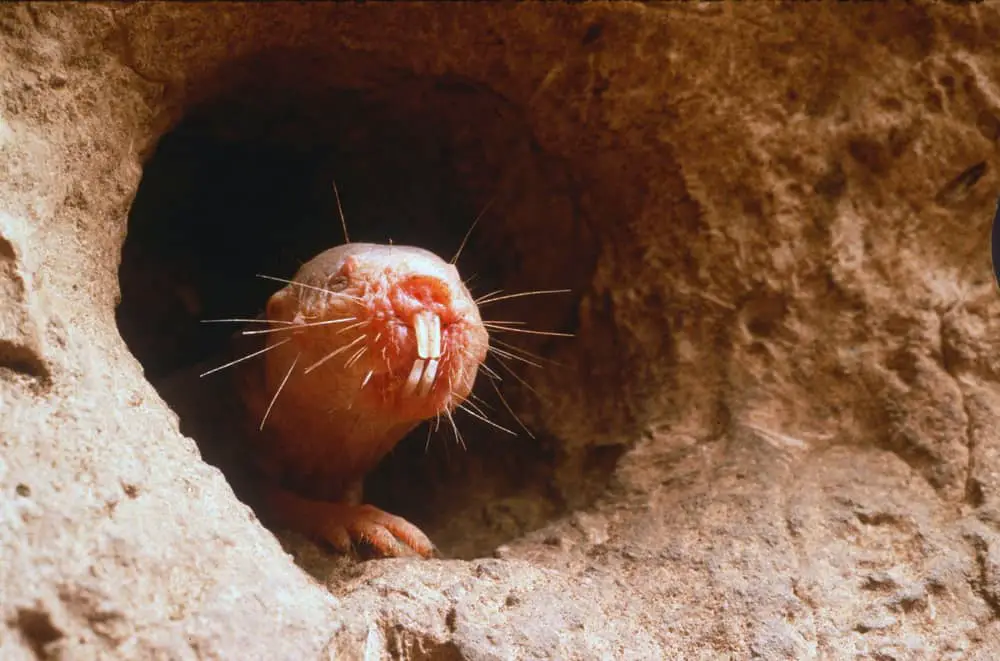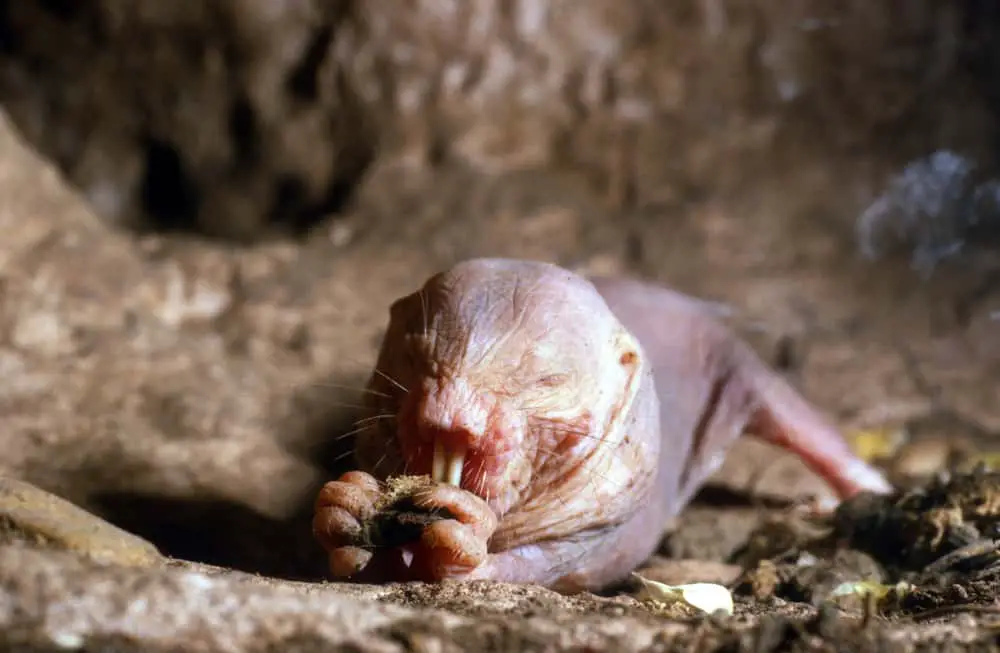Family Bathyergidae, commonly known as mole rats, are a group of underground-dwelling rodents found primarily in Africa. They belong to the family Bathyergidae and comprise 18 species that differ in various morphological characteristics such as fur color, dental patterns, and body size.
Mole rats are highly adapted to their subterranean lifestyle, with features such as narrow eyes, reduced external ears, and strong front limbs for digging. Mole rats have gained significant attention from researchers due to their unique social behavior, longevity, and resistance to cancer.
These animals live in large colonies composed of one breeding female (queen) and several non-breeding individuals who work together to maintain the colony’s burrow system. Moreover, some mole rat species have been shown to live up to 30 years – an exceptionally long lifespan for a rodent.
Additionally, they possess mechanisms that prevent tumor development despite frequent exposure to carcinogens present in their environment. In this article, we will explore the biodiversity of bathyergids and discuss their remarkable adaptations that enable them to thrive in challenging environments.

Genera
- Genus Bathyergus
- Genus Cryptomys
- Genus Fukomys
- Genus Georychus – Cape mole-rat
- Genus Heliophobius – silvery mole-rat
Morphological Characteristics Of Bathyergidae
Bathyergidae is a family of subterranean rodents commonly known as mole-rats. These peculiar creatures are found in Africa and have captivated the attention of scientists for decades due to their unique morphological characteristics that allow them to thrive underground.
To understand these features, it is crucial to examine the evolutionary history and comparative anatomy of this group. The evolutionary history of Bathyergidae dates back millions of years when they diverged from other African rodents.
Unlike most mammals, Bathyergids possess an array of traits that make them highly adapted to life underground, such as reduced eyesight, elongated incisors, and powerful forelimbs designed for digging. Moreover, molecular studies suggest that this group has undergone rapid adaptive evolution, which has driven diversification across different habitats within Africa.
Comparative anatomy shows remarkable similarities between species within the genus but also reveals significant differences among genera. For instance, Heterocephalus glaber (naked mole-rat) possesses specialized teeth used for tunneling while Fukomys anselli (Ansell’s mole-rat) has a complex skull structure with enlarged nasal turbinates responsible for thermoregulation.
Understanding the intricate details underlying these adaptations can help us unravel the secrets behind their successful survival strategy underground.
Adaptations For Underground Living
Bathyergidae, also known as mole-rats, are a group of subterranean rodents that have evolved remarkable adaptations to suit their underground lifestyle. These animals possess unique physiological and behavioral traits that allow them to thrive in harsh environments with limited resources.
One such adaptation is their highly specialized teeth; they have enlarged incisors that protrude outside the mouth and can be used for digging burrows and gathering food. Additionally, their eyesight has been reduced due to living in complete darkness, but they compensate by having an acute sense of smell and touch.
Furthermore, mole-rats live in complex social structures where individuals have specific roles within the colony. They are eusocial animals, meaning only one female reproduces while others serve as workers or soldiers. This system provides evolutionary advantages such as efficient resource allocation, increased reproductive success, and better protection from predators. However, it also results in high levels of relatedness among members of the same colony, which may lead to inbreeding depression if not managed well.
Overall, these unique adaptations have allowed bathyergidae to successfully inhabit various ecosystems across Africa and make significant contributions to soil health through burrowing activities.
The impact of mole-rat communities on terrestrial ecosystems is still being studied; however, research shows that these animals play critical roles in maintaining healthy soils and regulating nutrient cycling processes. Their extensive tunneling activity creates pathways for water infiltration into the ground, promoting plant growth and reducing erosion rates. Moreover, their fecal pellets serve as rich sources of nutrients like nitrogen and phosphorus necessary for soil fertility maintenance.
While some species’ populations are threatened by habitat destruction caused by human encroachment or climate change-induced alterations made to their natural habitats, understanding their ecological significance will aid conservation efforts aimed at preserving this vital part of our planet’s biodiversity.
Social Behavior Of Mole Rat Colonies
In the dark and labyrinthine tunnels beneath the African savannah, bathyergidae colonies thrive. These social rodents are known for their intricate burrow systems that house hundreds of individuals in a single colony.
It is fascinating to observe how they work together as one unit, using communication methods that have evolved over time to accomplish tasks such as food gathering and nest building.
Division of labor is key in mole rat societies. Each individual has a specific role based on age, size, and gender. For example, young males may act as sentinels, warning the colony of any potential danger while older females take on more maternal duties such as caring for young pups.
Additionally, these animals use vocalizations and scent marking to communicate with each other about important information like nearby predators or available resources. Their complex social structure demonstrates the importance of cooperation and communication when it comes to survival in harsh environments.
The intricacy of bathyergidae society highlights the incredible adaptability of nature.
Observing them at work can inspire us to value teamwork and collaboration in our own lives.
The division of labor within mole rat colonies shows us how every individual plays an essential role.
Communication methods used by these creatures remind us that language is not limited to human beings alone; there are many ways to convey messages effectively without words.
Longevity Of Bathyergidae
Factors Affecting Longevity of Bathyergidae
The longevity of an animal is determined by various factors, including genetics, environment, and behavior. In the case of Bathyergidae, their underground lifestyle may play a crucial role in determining their lifespan. These subterranean rodents have evolved to live in harsh conditions that require them to dig extensive burrow systems for protection from predators and fluctuations in temperature and humidity. This adaptation has resulted in unique physiological characteristics such as low metabolic rates and high resistance to hypoxia. Such adaptations are believed to contribute to their extended lifespans compared to other rodents.
When comparing the longevity of Bathyergidae with other rodent species, it is evident that they have significantly longer lifespans than most small mammals.
For instance, naked mole-rats (Heterocephalus glaber), which belong to the same family as Bathyergidae, can live up to thirty years under laboratory conditions while wild-caught individuals have been observed living up to twenty-eight years in the field. On the other hand, common house mice (Mus musculus) have an average lifespan of one year in the wild and about two years under laboratory conditions.
Other environmental factors that affect longevity include diet quality, exposure to pathogens and toxins, predation pressure, social structure among others. However, since these animals are mainly found in Africa’s southern regions where access is limited due to political instability or geographic isolation research on many ecological aspects remains scarce.
In summary, several factors determine the longevity of Bathyergidae: genetic makeup, physiology associated with underground dwelling lifestyles; immunity against diseases; predator avoidance mechanisms; food availability etc., all ultimately contributing towards enhanced survival chances over time when compared with other rodents like Mus musculus who exhibit shorter life spans due largely perhaps because they do not share some of those protective traits specific only amongst this particular genus’ members!
Resistance To Cancer
The resistance of bathyergidae to cancer is an intriguing topic that has attracted the attention of researchers in recent years.
A study conducted by Buffenstein and colleagues revealed that naked mole-rats, a member of the bathyergidae family, have a remarkable ability to resist cancer due to their unique biology.
These rodents live up to 30 years, which is highly unusual for small mammals, and they exhibit low rates of aging-related diseases such as cancer.
Researchers are interested in exploring how these animals can prevent cancer development through various mechanisms.
For instance, studies show that naked mole-rats possess high levels of hyaluronan (HA), a large glycosaminoglycan molecule found in connective tissue matrices.
This compound is believed to play a role in preventing tumor growth by creating an unfavorable microenvironment for cancer cells.
Additionally, naked mole-rats have efficient DNA damage repair systems that reduce the risk of mutations leading to cancerous growths.
The discovery of these unique features could pave the way for novel therapies with medical potential for addressing human cancers.
Incorporating knowledge from this species into further research on cancer prevention mechanisms could lead us one step closer towards developing effective treatments against this lethal disease.
By studying the biology and physiology of bathyergidae more closely, we may be able to identify new targets for therapeutic interventions or develop drugs based on their natural defenses against tumors.
Although much remains unknown about the molecular pathways involved in these defense systems, continued investigations will enable us to address pressing questions regarding human health and improve our understanding of biological mechanisms at work within this fascinating group of animals.

Biodiversity Of Bathyergids
Bathyergids are a family of subterranean rodents that have evolved to live in harsh underground environments. The evolutionary history of this group is not well understood, but molecular evidence suggests they diverged from other rodent families approximately 30 million years ago.
They are found exclusively in sub-Saharan Africa and exhibit a high degree of morphological diversity across their different species.
Bathyergids occupy an important ecological niche as ecosystem engineers, creating complex burrow networks that provide habitat for many other organisms. Their burrows also help aerate the soil and increase nutrient cycling, making them critical players in shaping African ecosystems.
Additionally, bathyergids play an important role in seed dispersal by transporting seeds from plants growing above ground into their burrows where they can germinate safely away from predators.
Overall, the biodiversity of bathyergids is crucial to maintaining the health and stability of African ecosystems.
Conclusion
Bathyergidae, commonly known as mole rats, are rodents that have evolved to thrive in underground habitats. These fascinating creatures exhibit unique morphological characteristics such as a cylindrical body shape and reduced eyesight and hearing abilities. Their adaptations for subterranean living include powerful digging claws and specialized teeth for gnawing through roots and tubers.
Mole rat colonies typically consist of a single breeding pair with multiple non-breeding individuals who assist in caring for the young and maintaining the burrow system. Social behavior within these groups is complex and includes vocalizations, scent marking, and grooming behaviors. Mole rats also exhibit remarkable longevity compared to other similarly sized rodents.
One particularly intriguing aspect of Bathyergidae biology is their apparent resistance to cancer. Researchers continue to investigate whether this phenomenon is related to their low metabolic rates or specific genetic factors.
Despite being relatively understudied compared to other rodent families, there exists considerable biodiversity among mole rat species across Africa.
In conclusion, bathyergid research has shed light upon many important aspects of evolutionary adaptation and social behavior in subterranean mammals. The study of these curious animals continues to reveal new insights into fundamental biological processes such as aging and disease prevention. As scientists we must not neglect the importance of studying ‘old-fashioned’ organisms like the mole rat – they may still hold secrets yet undiscovered!

